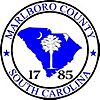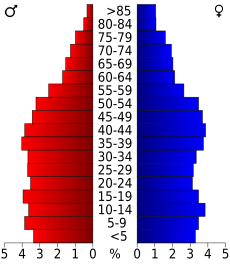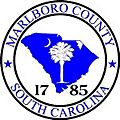Marlboro County, South Carolina facts for kids
Quick facts for kids
Marlboro County
|
||
|---|---|---|
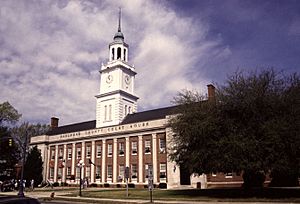
Marlboro County Courthouse in Bennettsville
|
||
|
||
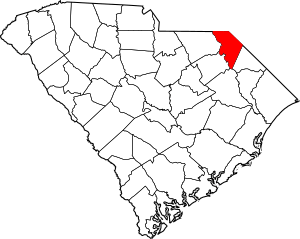
Location within the U.S. state of South Carolina
|
||
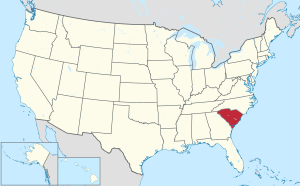 South Carolina's location within the U.S. |
||
| Country | ||
| State | ||
| Founded | 1785 | |
| Named for | John Churchill, 1st Duke of Marlborough | |
| Seat | Bennettsville | |
| Largest community | Bennettsville | |
| Area | ||
| • Total | 485.46 sq mi (1,257.3 km2) | |
| • Land | 479.87 sq mi (1,242.9 km2) | |
| • Water | 5.59 sq mi (14.5 km2) 1.15% | |
| Population
(2020)
|
||
| • Total | 26,667 | |
| • Estimate
(2023)
|
25,704 | |
| • Density | 55.57/sq mi (21.46/km2) | |
| Time zone | UTC−5 (Eastern) | |
| • Summer (DST) | UTC−4 (EDT) | |
| Congressional district | 7th | |
Marlboro County is a county in the Pee Dee region of South Carolina. It's located on the northern border of the state. In 2020, about 26,667 people lived here. The main town and county seat is Bennettsville. The Great Pee Dee River flows through the county.
Marlboro County is special because it's home to the Pee Dee Indian Tribe. This tribe has lived in the Pee Dee region for hundreds of years. South Carolina officially recognized them around the year 2000. They have been working to get federal recognition since 1976. Even though there are only about 200 members today, they were once very powerful. Their long history in the area is why the region is called "Pee Dee." Since 1976, the tribe's government has been on land given to them in Marlboro County.
Contents
History of Marlboro County
Early Inhabitants and Culture
For thousands of years, different groups of indigenous peoples lived in this area. When Europeans first arrived, the Pee Dee tribe lived here. Even though many were lost due to wars, diseases, and other hardships, the Pee Dee Indian Tribe survived. They have kept their presence in the area through the centuries.
In the 1960s and 1970s, researchers found many old sites in South Carolina. These sites are linked to what is called the South Appalachian Mississippian culture. Settlements started around the year 1000 AD.
Town Creek Indian Mound is a famous site across the border in North Carolina. It's a special platform mound and village site of the Pee Dee culture. People lived there for about 200 years, leaving around 1150 AD. In 2017, the Pee Dee Indian Tribe began working on their own Pee Dee Tribal Mounds. These are located on tribal land in McColl.
European Settlement and County Creation
The first European settlers in the area were Welsh families. They came from other British colonies, moving south from Pennsylvania. In 1737, they started the first European-American settlement called Welsh Neck. They also set up a Baptist church in January 1738.
The South Carolina government gave 173,000 acres of land only to Welsh settlers in 1737. Within ten years, most of this land was settled by Welsh immigrants. Most of them were Baptists. They came to what is now Marlboro County from older Welsh settlements. Some also came directly from Wales. For about 50 years, from the 1730s to the 1780s, the area along the Pee Dee River was mostly settled by Welsh people.
On March 12, 1785, Marlboro County was officially created. This happened during the American Revolution. The county was named after the Duke of Marlborough. At first, it was part of a larger area called Cheraws District. In 1800, Marlboro became its own district. Later, in 1868, during the Reconstruction era, South Carolina districts became counties.
The first courthouse was built near the Great Pee Dee River. It was in a village called Carlisle. To make the county court more central, Bennettsville was chosen as the new county seat in 1819. A new courthouse was designed by Robert Mills. It was started in 1820 and finished in 1824. This courthouse was later replaced and then expanded in the 1950s.
Geography and Nature
Marlboro County covers about 485 square miles. Most of this is land, with about 5.59 square miles of water.
Protected Areas
- Lake Paul Wallace Wildlife Management Area is a special place for nature.
Rivers and Lakes
- Crooked Creek
- Little Pee Dee River
- Great Pee Dee River
- Lake Wallace
Neighboring Counties
Marlboro County shares borders with several other counties:
- Richmond County, North Carolina – to the north
- Scotland County, North Carolina – to the northeast
- Robeson County, North Carolina – to the east
- Dillon County – to the east
- Florence County – to the south
- Darlington County – to the southwest
- Chesterfield County – to the west
- Anson County, North Carolina – to the northwest
Population and People
| Historical population | |||
|---|---|---|---|
| Census | Pop. | %± | |
| 1790 | 10,706 | — | |
| 1800 | 5,452 | −49.1% | |
| 1810 | 4,966 | −8.9% | |
| 1820 | 6,425 | 29.4% | |
| 1830 | 8,582 | 33.6% | |
| 1840 | 8,408 | −2.0% | |
| 1850 | 10,789 | 28.3% | |
| 1860 | 12,434 | 15.2% | |
| 1870 | 11,814 | −5.0% | |
| 1880 | 20,598 | 74.4% | |
| 1890 | 23,500 | 14.1% | |
| 1900 | 27,639 | 17.6% | |
| 1910 | 31,189 | 12.8% | |
| 1920 | 33,180 | 6.4% | |
| 1930 | 31,634 | −4.7% | |
| 1940 | 33,281 | 5.2% | |
| 1950 | 31,766 | −4.6% | |
| 1960 | 28,529 | −10.2% | |
| 1970 | 27,151 | −4.8% | |
| 1980 | 31,624 | 16.5% | |
| 1990 | 29,361 | −7.2% | |
| 2000 | 28,818 | −1.8% | |
| 2010 | 28,933 | 0.4% | |
| 2020 | 26,667 | −7.8% | |
| 2023 (est.) | 25,704 | −11.2% | |
| U.S. Decennial Census 1790–1960 1900–1990 1990–2000 2010 2020 |
|||
In 2020, Marlboro County had 26,667 people living there. There were about 9,613 households and 6,069 families. The population has changed over time, as you can see in the chart.
In 2010, the county had 28,933 people. About half the population was Black or African American, and about 41% was White. Around 4.5% were American Indian. The average age of people in the county was 38.8 years old.
Economy and Jobs
In 2022, the total value of all goods and services produced in Marlboro County was about $918.3 million. This is like the county's total income.
Some of the biggest employers in Marlboro County include:
- The United States Department of Justice
- Domtar (a paper company)
- Food Lion (a grocery store)
- Domino's (a pizza company)
- Walmart (a large retail store)
Many people in the county work in manufacturing (making things), health care, and public administration (government jobs).
Transportation
Main Roads
Marlboro County has several important roads that help people travel. These include:
 I-95 (a major interstate highway)
I-95 (a major interstate highway) US 1 and
US 1 and  US 15 (U.S. highways)
US 15 (U.S. highways)- Several South Carolina state highways like
 SC 9 and
SC 9 and  SC 34.
SC 34.
Airports
- Marlboro County Jetport is a local airport.
- Larger airports like Myrtle Beach International Airport and Charlotte International Airport are a bit further away.
Communities
Cities
- Bennettsville: This is the main town and the county seat.
- Cheraw: Most of this city is in Chesterfield County, but a small part is in Marlboro County.
Towns
Other Communities
- Wallace is a census-designated place. This means it's a community that the census bureau defines for statistics.
Images for kids
See also
 In Spanish: Condado de Marlboro para niños
In Spanish: Condado de Marlboro para niños


